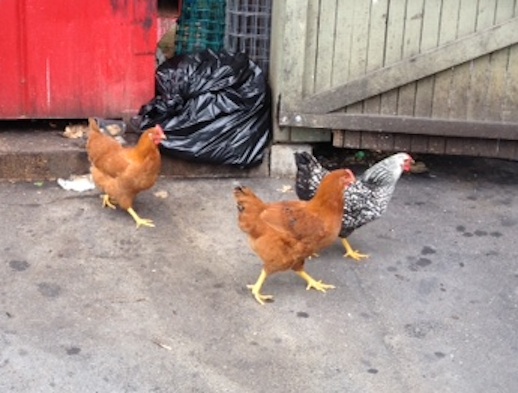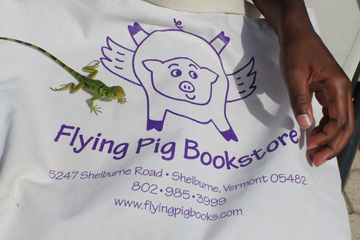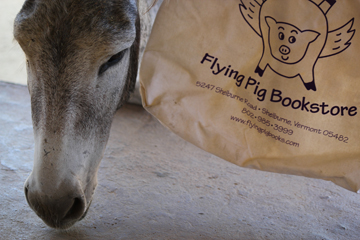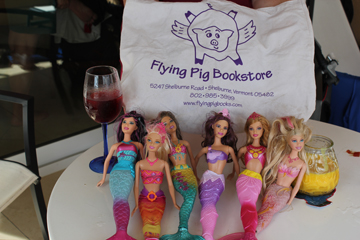I have been asking myself this question a lot lately. Every event has its own questions that make me tense. Will enough people come to the event (and it turns out that my view of this and an author’s view can be vastly different)? Will I have enough books? Will I have the right mix of books? Will the author show up? Will people who came to the event have a good time and leave feeling enriched? Will my press release run in the paper without me needing to pay for an ad first?
The past year we’ve had a lot of different kinds of events, ranging from Fancy Nancy and other New York Times bestselling authors, to a local poet with small press release. Obviously, different events will draw different crowds. More than 200 people, most of them in tiaras, showed up for Fancy Nancy. The poet drew almost 30 and that was fabulous.
There is a deep, dark secret that most bookstores will not talk about: sometimes, medium to big name authors don’t draw the crowd they’re expecting. There is nothing more disheartening than having a bestselling author who doesn’t draw the hundred he or she is expecting. Yes, we’re in a small town, but we can pull over 200 for certain events, and others only get 50. To me, a 50-person event is still a good event. But for some authors this is not enough.
Generally, authors are seasoned enough to know that sometimes, even with the best media push, a large crowd just isn’t going to materialize. Of course everyone is unhappy, but most of us are professional enough to hide our disappointment until after the event. After 16 years of being in business, I still can’t figure out what events will spark a huge crowd and what events that should be huge are mid-sized or small instead.
We had an event for a paperback release with a very well known regional author that only had 40 people in attendance. The 40 people in attendance had a great time, which is a testament to the author’s skill and adeptness at hiding his disappointment at the size of the crowd. I thought the event was fabulous because all of those in attendance had really felt a real connection to the author. Books were bought and signed and I thought all was good.
The following morning we received a pointed email from the author (which was shared with the publicist) suggesting that unless we could guarantee at least 150 people at the next event, there would be no further visits from him. Once I calmed down, I realized the request was a tad unrealistic. I have no way of guaranteeing any size crowd. Even when people RSVP, they don’t always show up; there are snowstorms, lacrosse tournaments, etc. The list goes on as to why folks sometimes miss an event they were excited to attend until their life got in the way. Perhaps my town shows a laissez-faire attitude toward someone they think of as a local (even though he’s not, but it’s sweet how folks like to claim him as their own) and they don’t rush out for a paperback release event. It was a frustrating time for all involved. But to be told, essentially, I’m better than your store, is galling to say the least and shortsighted at worst.
What publicists and authors need to understand that not every event is going to a crush of hundreds of people. But having a good event means that the folks attending will remember you and your work. They will tell their friends about how wonderful it was to meet you and talk to you about your work. And most importantly, they will now become loyal fans who will not only buy your books, they’ll give them as gifts.
I explained this in an email to both the author and the publicist. I don’t think much will change, but I know from a bookseller’s perspective, we still had a great event, and folks from that event still come to thank me for having the author to the store.
Monthly Archives: August 2012
This Doesn’t Happen Every Day
Josie Leavitt - August 10, 2012
My store is in Vermont, in a small yet bustling village. Vermont by its very nature is thought of a rugged state full of great nature moments. There’s even a black bear roaming around my neighborhood. But Shelburne Village has not been a hotbed of wild animal activity because it’s too densely populated with people.
The bookstore shares a large trash dumpster with two restaurants and a dozen apartments. In the summer, trips to the dumpster can include fending off crows that are strong enough to actually carry a bag of trash out of the dumpster to squirrels who literally pop through the hole they’ve chewed in the lid when opened. Once a baby raccoon fell in the dumpster and a very smart young man put a long 2×4 in the bin and less than two minutes the little one scampered out and was reunited with his mother. I sort of expect the rodent-types now at the dumpster, but yesterday there was something that made me laugh.
 Free-range chickens were pecking away at the base of the trash area. I never assumed that there was a flock of free-range chickens living in the village. And it never occurred to me that I’d see a small flock of someone’s chickens at the bookstore dumpster. I tried to get as close as I could to take the photo and the chickens regarded me ruefully. They turned and headed home, scratching the pavement as they went through three stores’ parking lots to get back to wherever they came from.
Free-range chickens were pecking away at the base of the trash area. I never assumed that there was a flock of free-range chickens living in the village. And it never occurred to me that I’d see a small flock of someone’s chickens at the bookstore dumpster. I tried to get as close as I could to take the photo and the chickens regarded me ruefully. They turned and headed home, scratching the pavement as they went through three stores’ parking lots to get back to wherever they came from.
Now that we’ve discovered chickens at the trash, more staffers are volunteering to take the garbage out.
Hand Kids Some Great Nonfiction!
Elizabeth Bluemle - August 9, 2012
In a discussion on the ccbc-net listserv about the Michael L. Printz Award turning 13 this year (awww, the teen award is becoming a teen! kudos to clever CCBC Director Kathleen T. Horning for noting this anniversary), some interesting observations were made about the overwhelming preponderance of fiction in the winner and honor lists.
Some members felt that publishers are not making enough room on their lists for nonfiction these days; others theorized that specific nonfiction awards like the ALSC‘s Robert F. Sibert Award and the NCTE‘s Orbus Pictus Award have contributed to a perhaps subconscious prioritizing of fiction in the general awards. A few souls decried the lack of excellent nonfiction available for contemporary kids and teens, but their protests were quickly countered by many passionate nonfiction lovers, who pointed to authors and titles that not only they, but their students, love passionately.
As a bookseller, I do notice many things about how nonfiction for kids reaches its end user. I notice that it can be all too easy to recommend only fiction to young readers. We can fall into the lazy and erroneous trap of assuming kids will prefer fiction, that they will associate nonfiction with school and reports and unwanted required reading. We can forget how interested in the world kids are, and how much they yearn to learn and know things, to discover and pursue passions for history, the natural world, sports, science, animals, the lives of fascinating people.
It’s possible there’s a gender piece operating here. We know from reading habits among adults (sweeping generalization alert!) that men tend to read more nonfiction than fiction, and the reverse is generally true of women. Of course there are myriad exceptions to this, but anyone who works in a bookstore can probably attest to the general truth of this divide. And because children’s bookselling is predominantly a female field, and because more moms than dads shop for books for their kids (at least at our store, but I suspect in others, too), I wonder if we booksellers sometimes unconsciously bring our own preferences into play and lean heavily toward recommending fiction to kids searching for pleasure reading.
It’s worth reminding ourselves and our staff not to overlook nonfiction, to read and review and share book talks with each other that will hook kids the same way we lure them into fiction.
I do think publishers can help promote their children’s nonfiction better to young readers themselves, by making sure the books have visual appeal. Adult nonfiction has great cover art, but sometimes the kids’ books look, well, dull. Also, it would be fantastic if publishers provided the kinds of promo hooks — the one-liners that grab readers — we get for fiction titles. These, along with a fantastic review quote or two, could appear on the jackets. Heck, have Rick Riordan or John Green blurb some great nonfiction and see what happens. (Kidding, but not really.)
And booksellers? Let’s challenge ourselves to throw two nonfiction titles in with every stack of potential reads we hand to our young customers. I’m creating a database of fantastic, kid-appealing nonfiction for youth here, and welcome suggestions.
Readers, what 2012 nonfiction titles are you reading and loving? And — what is the one-sentence hook you’d use to entice a reader to pick them up?
Little Shoppers
Josie Leavitt - August 7, 2012
I love it when little kids come to the store and shop for the first time. Our goal here is to make shopping for books for fun. The beauty of making the kids comfortable in the store is that the parents relax, and this makes for a much better shopping experience.
Children like what’s familiar. There is a real delight in watching a young child at the bookstore. They marvel at all the books, usually exclaiming with pure joy, “We have that!!” To them, it’s sort of amazing that we have the same books they do.
Then there is the inevitable discussion about the difference between the bookstore and a library. This conversation usually occurs after a tot has amassed all the books he has at home. It’s really interesting to watch parents explain the concept of what buying something means. Little ones just have no idea yet. This is something, though, that they learn to grasp very quickly. It’s always a little heartbreaking to see a small child navigate the very complex dynamic of what gets purchased and what gets re-shelved, often on the sly, to avoid upsets.
Then there are the kids who don’t want help finding their books. They like to look at everything before deciding where they should settle down. These one spend much of their time in the young adult section asking, “Are these big kid books or little kid books?” Already, at a young age, these guys want the big kid books. Little kid books are for little kids, and doesn’t every little kid want to be a big kid?
Occasionally, there will be kids who think board books make great skates. I see them sliding slowly on the rug in the baby section. They are adorable and while it’s probably not a great thing for them to do, if they are in socks, I let them slide away.
Perhaps my favorite thing, just because it’s so incongruous, is when a child under the age of three hands me a credit card. Usually the card has been licked in some way or has little fingerprints on it from hot little hands trying to hold on to it. I take the card and smile and explain they can have it right back. Otherwise, the kids can just start crying as if to say, why’d you take that away? Our scanner has a long cord which enables us to let the littlest shopper keep her book while we ring it up. This saves lots of tears and it’s fun for them to hear the beep.
I love seeing a small child’s head just below the counter with a book she wants. I look at this little shopper and see the future of independents everywhere. This child needs to feel that my store is different than any other store. The kids are too little to know the difference, but I think it’s important that all kids, no matter how young, come to the bookstore feeling welcome.
Nothing warms my heart more than a kid shouting, “I love this store.” We are lucky that we hear this a lot.
When Pigs Fly
Elizabeth Bluemle - August 6, 2012
Summer is our busiest season, aside from the winter holidays, so while our customers are living it up by the lake, taking fantastic trips, and generally acquiring the glow of a life lived outside, we are pretty much adhered to the inside of the store. This gives us a sort of insouciant pallor and buck-up martyrdom in the face of Vermont’s relentless outdoor beauty.
All is not shelving and alphabetization and sideline buying and mad book restocking, however. Occasionally we get dispatches from the only member of the Flying Pig family who gets to go on vacation: our tote bag. Yes, little Hamlet sees the world from his two-dimensional, soy-ink spot on eco-friendly canvas, and we occasionally get postcards from the hinterlands in the form of photos sent by our customers.
Recently, we received a few from Aruba. But first, some background.
A new customer, Shea, and her partner, Tessa, brought their kids, LaRon (16) and Ty (8) into the store for the first time to stock up on books for vacation. We’d run across Shea and Tessa (friends of my sister’s) a few times outside of work, but this was the first time we’d met the kids. They’re the kind of family where humor reigns supreme; they give each other constant, affectionate grief and are all four astute and comical observers of human absurdity. Needless to say, we had a great time in the store, with much laughter and many book recommendations. They left with a bunch of new reads, stuffed into the Flying Pig tote bag they’d earned with their purchase.
That evening, I received an email from Shea, whose subject header read: “Here’s what you missed after we left,” followed by a little family dialogue:
Shea: “You think so?”
LaRon: “Yeah….and not in the creepy sort of way.”
Ty: “Yeah, but pigs can’t really fly….”
Tessa: “I got nothin’.”
Shea: “Good to know.”
I was both gratified and relieved to discover that I had been helpful — and not in a creepy sort of way. Warms the cockles of my bookselling heart, that does. I wrote back to thank them for their votes of confidence (and to protest to Ty that pigs in fact do fly, as evidenced by the very existence of our store, harrumph).
It was an amusing surprise when more emails began to arrive, this time from Aruba. With photos. Turned out Hamlet, our bookstore mascot on canvas, was having a high old time. He’d made friends with a curious lizard and a donkey, provided a soothing background for some Barbies and their Cosmopolitans (no idea what was going on there; didn’t ask; didn’t want to know), and — in a stunning finish — ventured underwater for his first scuba dive.
Over the years, we’ve received a sprinkling of marvelous travel photos from customers with their Flying Pig totes. This latest round is inspiring us to find a place on our website, and our Facebook page, to create a gallery for these shots, and to invite more. One of these days, we figure we’ll just stow away in one of our totes. Surely no one will mind a couple of helpful booksellers along for the ride?
(Note: We changed the names of the customers who visited Aruba, and received permission to use their email and photos for the blog post.)
A New Partnership in the Simplest Way
Josie Leavitt - August 3, 2012
A new restaurant/bakery opened next door to us last week. It’s called The Next Door Cafe and it’s run by the same folks who run the Bearded Frog, the dinner restaurant in our building. I have always enjoyed the folks who run the Frog, as we call it.
I have been worried about sharing our rather small parking lot with a restaurant that promises to be very busy all the time. I was speaking to the manager about this and he suggested some sort of reciprocal marketing. In a very simple, and extremely cost-efficient way, we are promoting each other’s places with our register receipts. At the bottom of each receipt is a simple statement: Bring this to the Next Door Restaurant (theirs says Flying Pig) for 10% off any one item. Good today only.
This has been a huge boon to us and them. For us, it’s ensuring that some of their customers become our customers. And for the restaurant it gives patrons something to do when it takes a little longer for their food to arrive. Already, the staff has called over to the bookstore to let us know that someone’s order is ready. As I ring folks up, I happily tell them about the new place and suggest they go over with their books and have a pastry.
We have been collecting the receipts daily just to track them. In one day we got 12, and only 3 of those 12 were regular customers. This is a wonderful way to get new people into the store without spending a penny. The momentum can only build. The restaurant is so new they don’t even have a sign yet. Another great thing about this new lunch place is we no longer have to worry about not having food at work. Only one restaurant delivers and it’s only pizza. If someone forgets her lunch and is working alone, there is precious little that can be done in terms of getting food. But being able to call something in and walk 10 feet around the building makes life a little easier.
Working with other retail places has never been this easy or this fun. The food is great and they serve Bloody Marys on Sundays.
Premise Kings and Queens
Elizabeth Bluemle - August 2, 2012
Some writers have an incredible gift for great premises — the kinds of storylines that make you say, “Oooh! Why hasn’t anyone thought of that before?!” (Or, if you’re a writer, “Oooh! I wish I’d thought of that!”)
I suppose what I’m talking about here is what Hollywood refers to as “high concept,” a deceptive phrase that doesn’t mean “artistically lofty” (which I’d first thought a million years ago when I heard the term), but ‘having an immediately recognizable, fantastic hook.’ In bookselling terms, this translates into a one- or two-line summary that is so compelling it grabs readers immediately.
A recent ad for David Levithan’s upcoming novel, every day, drew me in with the log lines: Every day a different body. Every day a different life. Every day in love with the same girl. What a great idea! Who would not want to read that?! (Or see it; this has got to be optioned already.)
Levithan is always, always terrific with premises — even with his realistic fiction, which isn’t nearly as easy to render high concept as fantasy. His books with Rachel Cohn are great examples. Nick and Norah’s Infinite Playlist: “Told in alternating chapters, teeming with music references, humor, angst, and endearing side characters, this he said/she said romance is a sexy, funny roller coaster of a story about one date over one very long night.” And Naomi and Ely’s No-Kiss List: “Naomi is in love with her best friend, Ely, but Ely prefers boys. So they create a “No Kiss List” of people neither of them is allowed to kiss. It works fine — until Bruce enters the picture.” So simple, so strong, so utterly teen-appealing.
This got me thinking about other writers who have a particular gift for premises.
Margaret Peterson Haddix has always been a master. She asks “what if?” in some utterly compelling, page-turning ways. Her books are some of the easiest handsells a bookseller could ever ask for. All we have to do is sum up the premise and the book is out of our hands into the kids’ before we’ve finished speaking. [Note: the annotations below are edited versions of the publishers’ marketing materials. This is pretty close to how we chat up the books to customers.]
A few of Haddix’s goodies include:
Running Out of Time : When a diphtheria epidemic hits her 1840 village, 13-year-old Jessie discovers she has actually been living in a 1995 tourist site under unseen observation by heartless scientists….
Among the Hidden: Luke, a third child in a future where families are forbidden to have more than two offspring, has lived his life as a shadow child, in hiding — until one day when he spies a girl, a ‘third’ like himself, peering out an attic window in a house nearby. She has a dangerous plan to challenge the powerful government, and wants Luke to join her.
Turnabout: After secretly receiving injections at the age of 100 that are meant to reverse the aging process, Melly and Anny Beth grow younger and younger. It was great for a while. But now they’re 16; what’s going to happen as they become more and more helpless?
Other YA standouts who leap to mind, delivering great premises time and time again, include Scott Westerfeld, E. Lockhart, John Green, Susan Beth Pfeffer, Meg Rosoff, Terry Pratchett, Nancy Farmer, Diana Wynne Jones, Philip Reeve, Shannon Hale, Suzanne Collins, Tamora Pierce, Philip Pullman, and M.T. Anderson. There are many more — the difficulty here lies in distinguishing between great storytelling, and coming up with a great premise, which is what this post is celebrating.
Readers, booksellers: Who are your kings and queens of the stellar premise? Bonus points if you provide your favorite one- or two-line pitch for their books! (To qualify as royalty, in my mind, the author must have more than one terrific premise to his or her credit.)




